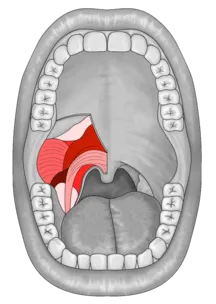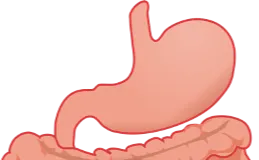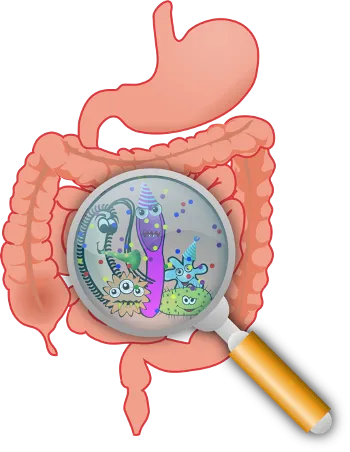Understanding the anatomy of the Gastro-Intestinal Tract (a.k.a. your gut)
Do you suffer from IBS, gas, or other gut issues, you need to have a basic knowledge of the digestive system. The information I include in this webpage should provide a good overview. However, if you still have questions, talk to your doctor. |
First Step: The Mouth
Food’s first step in the digestive process begins in the mouth. More than just mastication (chewing your food into manageable pieces) occurs here. Your saliva plays a role. It contains chemicals (specifically, an enzyme called amylase) that begin breaking down the sugars in food.
For the chemical breakdown to work optimally, you should chew the food twenty (or more) times a bite. All of that chewing breaks down the food, increasing its surface area, so more of it comes in contact with the saliva and other biochemicals farther along in the GI tract.
FYI, a dysfunctioning jaw can negatively impact your digestive health. If you jaw hurts, clicks, pops or locks, we can help.
Second Step: The Stomach
The chewed food gets broken up into even smaller particles in the stomach. Acidic stomach juices break down the food chemically, while the stomach’s churning contractions break down the food mechanically even further.
Third Step: The Small Intestine
The small intestine is broken up into three parts: the duodenum, the jejunum, and the ilium.
Duodenum
The duodenum is the first part of the small intestines and is attached to the stomach. The duodenum has glands that excrete fluid that neutralizes stomach acid.
A lot of chemical breakdown of your food occurs here. The pancreas dumps its digestive enzymes into the duodenum to break down sugars, proteins, and fats to their smallest size. The gallbladder dumps its stored bile (produced by the liver) into the duodenum to break down extra fats.
We need fat in this small, broken-down form to emulsify (break down into smaller particles and mix) fat-soluble vitamins for absorption farther down the small intestine.
Jejunum
Most of the food absorption is done in the jejunum. It absorbs simple sugars, most water-soluble vitamins, and amino acids (protein) from the food we eat. These nutrients enter the blood where it is distributed to feed all of the cells in our body.
Ileum
As the GI tract extends toward the colon, the lining of the small intestine’s walls thin, and blood vessels become sparser. Nothing definitive separates the jejunum from the ileum, but the last part of the small intestine is different enough in anatomy and function that it was given a different name—the ileum.
The final absorption of nutrients occurs in the ileum. Anything left over passes into the cecum (the beginning of the large intestine).
Fourth Step: The Large Intestine
The large intestine is also broken up into three parts: the cecum, the colon (ascending, transverse, and descending), and the rectum.
Cecum
The small intestine meets the large intestine at the cecum in the lower right abdominal region.
Colon
From the cecum, the unabsorbed food particles (which you’d never recognize as food at this point) travel up the ascending colon, across the transverse colon, and down the descending colon. When the fecal material travels through the colon, fluid is soaked up—up to 50 fluid ounces of water every day!
Rectum (the final step)
The rectum is the last stop in the digestive system. The fecal matter exits the body through this part of the large intestine.
The Appendix
(Not Just a Useless Organ)
The appendix is attached to the bottom of the cecum. Mainstream medicine considers the appendix a vestigial organ because it has no known purpose. Because no one is sure of its function, the appendix is thought to be left over from an earlier ancestor in our evolutionary development.
I disagree!!!
I prefer the hypothesis that the appendix is part of the mechanism that helps our body determine what is a foreign bad bug and what is ingested good stuff—the building materials that make the cells that make us.
Have you ever wondered how your body tells a good bug from a bad bug? How does it determine that the particles in our sinuses are pollen, dust, viruses, bad bugs, or our own cells? Well, this supposedly “useless” organ, the appendix, may be part of the answer.
I believe poor gastrointestinal health is why autoimmune conditions are on the rise. We need a healthy gut so our bodies can distinguish foreign bad bugs from our own healthy cells. I talk more about this when I explain what to do about food sensitivities and allergies (CLICK HERE to learn more)
The colon houses good bacteria—symbiotic organisms that help us digest our food. These organisms live off the fiber that isn’t digested and make vitamins K and B12, which the colon can absorb; they also produce gas.
New research has linked the health of the probiotics (the good bugs; more on these in Chapter 10) in our colon and the health of our immune system.[1] Some research has found that good bacteria in the gut support a healthy mind.[2] So eating well helps you think well!
Other studies have found that poor bacterial health in the gut can affect general joint health.[3] So eating well helps you move well.
Are you beginning to see how everything in your body is interrelated? This is why I always come back to the triad of health. When you eat/drink well, stretch/exercise well, and think/sleep well, you combat dis-ease!
Basically, having a healthy amazon of bacteria in our gut results in health benefits beyond the health of our entire digestive system.
[1] El Enshasy, et al., “Anaerobic Probiotics: The key microbes for human health,” Advances in Biochemical Engineering/Biotechnology.
[2] Stein, “Gut Bacteria Might Guide the Workings of Our Minds,” Morning Edition. NPR.
[3] Kohn, “Joint Pain, from the Gut,” Atlantic.





